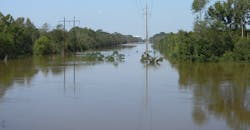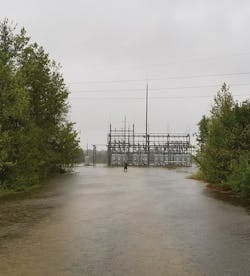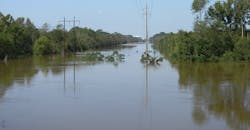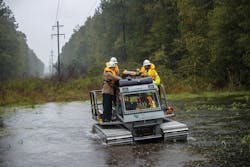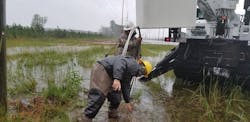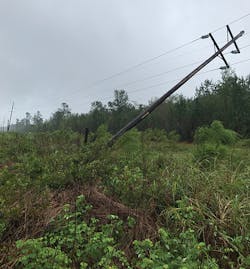Tropical Storm Floods Santee Cooper Service Area
When hurricanes unleash their destruction, they often rapidly weaken and then dissipate. Hurricane Florence, however, moved very slowly—sometimes at only 3 miles an hour—dumping a significant amount of rain on South Carolina and North Carolina.
By the time Hurricane Florence made landfall on Aug. 31, 2018, it was downgraded from a Category 4 hurricane to a tropical storm. Even so, the severe weather event still flooded Santee Cooper’s service territory.
Due to the extended duration of the storm, Santee Cooper had to wait to release the crews to start restoration work. Compounding the challenge, the storm also produced water funnels and tornadoes, which wound up grounding the helicopter contractors, further delaying restoration efforts.
Inflicting Damage
Like other storms of the same magnitude, Tropical Storm Florence produced typical damage from the strong winds. The real threat, however, was the floodwater, which made its way into Santee Cooper’s facilities within a week to 10 days. The flooding not only caused immediate threats to South Carolina utility’s system but also unforeseen damage such as saturation of the ground. As such, the next time the area has a major wind event, it could cause more trees to topple due to a weakened root system.
High winds also knocked over transmission structures or caused them to lean excessively. In addition, the winds blew trees on to the conductors, which in some cases, led to a lock-out. If the weight of a tree exerted stress on the structures or insulators, it could cause failures and lead to further damage.
Following the storm, Santee Cooper had 33 delivery points that were out, and the crews restored power to all the customers within five hours. The crews were not allowed to work outside if wind conditions exceed 35 mph, but once the winds died down, the linemen were given the green light to begin restoration.
Following an Action Plan
Before the rain started to fall and the winds picked up speed, Santee Cooper had already adopted an Emergency Action Plan (EAP) for Power Delivery Disasters. This manual included a set of procedures to assist in restoring service during emergency situations.
If Santee Cooper determines that a threat exists for a substantial portion of the power system, then the utility will activate the EAP, and the Energy Control Center will declare the appropriate operating condition (OpCon) level (4, 3, 2 or 1) after consulting with the system coordinators.
Depending upon the OpCon level, Santee Cooper’s crews will perform different tasks. For example, OpCon 4 is the lowest level, and it will put the company on notice to perform such duties as filling up all the fleets with fuel, printing updated maps and charging all electronic devices used to review the system including GPS units, iPads and laptops.
As the highest level, OpCon 1 requires tasks such as the removal of automatic reclosing on selected transmission circuits, splitting selected looped circuits, reviewing ride-out plans and performing after-storm reporting with employees.
In between OpCon 4 and OpCon 1, the employees are also moving computers away from windows, putting bags around computers and acquiring provisions such as water, food and shelter. The utility employees are also responsible for calling contract crews for assistance, and opening up projects and tasks to capture time and material to report to FEMA.
Leveraging Special Equipment
In the aftermath of Florence, Santee Cooper’s transmission maintenance department leveraged equipment to restore power and rebuild infrastructure swiftly. For example, the crews relied on unmanned aerial vehicles or drones for storm damage inspections as well as evaluations of the dams around the ash ponds.
The utility used an Access Database to record outages, fault locations and storm damage to be shared among the Energy Control Center, the relay and the storm center(s).
Santee Cooper also relied on Google Earth and its geographic information system to share outage/line status, fault locations, delivery point status and damage on the system to the internal customers. The South Carolina Department of Transportation and NOAA provide Google Earth data to show road conditions and weather information and river gauges to help to predict where flooding may occur. With this approach, the utility could keep individuals out of its storm center so it could concentrate on its work vs. answering questions on the system status.
Santee Cooper’s crews also operated special equipment such as Spidertracks, which could track the helicopter contractor aircraft as they flew over the system. The utility and its contractors turned to saw helicopters and a topping saw helicopter to perform the necessary work.
To navigate the water and swamp-like conditions, the utility and its contractors drove equipment on flex tracks. To stay safe when working in floodwater, the linemen wore flotation devices and conducted their work per the guidelines of the National Electrical Safety Code.
Along with special equipment, Santee Cooper also pulled in additional resources. For example, the utility called upon Rotor Blade to provide four helicopters to handle vegetation issues and provide post-storm observations; four Southeast Power crews or electrical contract crews for storm restoration; one Northeast Service Corp. crew; and six Tree Inc. crews for vegetation restoration.
Moving Forward
After restoring power, Santee Power and its contractors then focused on other issues caused by the storm damage. For example, the crews had to handle vegetation/right-of-way issues, fix leaning transmission structures and replace broken insulators.
When replacing the infrastructure, Santee Cooper crews had an in-kind replacement strategy by rebuilding its system as long as material is available. For example, the utility would replace a 65-ft wood HP-3 structure with the same structure.
Even after the storm had passed, Santee Cooper had to monitor and work to strengthen an ash pond from surrounding flooding. Also, the utility had to prepare for local rivers, which were cresting in the area, as well as continue to monitor its transmission system, which could sustain further damage from the flooding due to weakened tree systems from the ground saturation and the high water table. In turn, trees could fall on to its system, leading to further outages.
Every time a storm blows through Santee Cooper’s service territory, the damage, the response and the rebuilding effort may all be different. One thing remains constant, however—the utility works to get its customers’ power back on in the least amount of time and in the safest way possible.
About the Author
Eddie Taylor
Eddie Taylor ([email protected]) is a senior GIS analyst for Santee Cooper in Moncks Corner, South Carolina.
